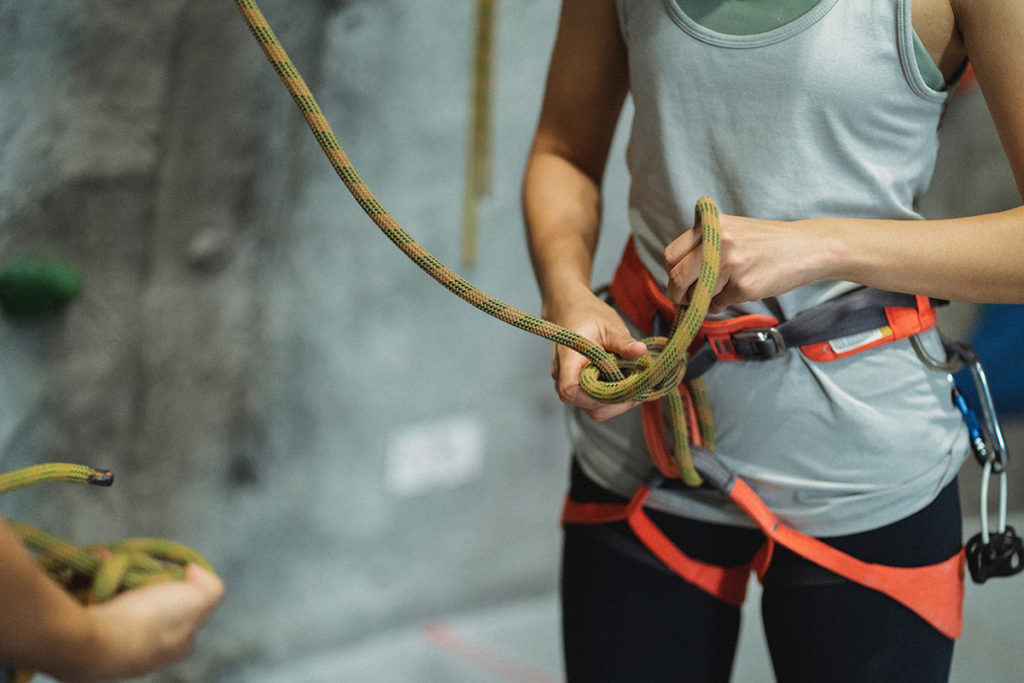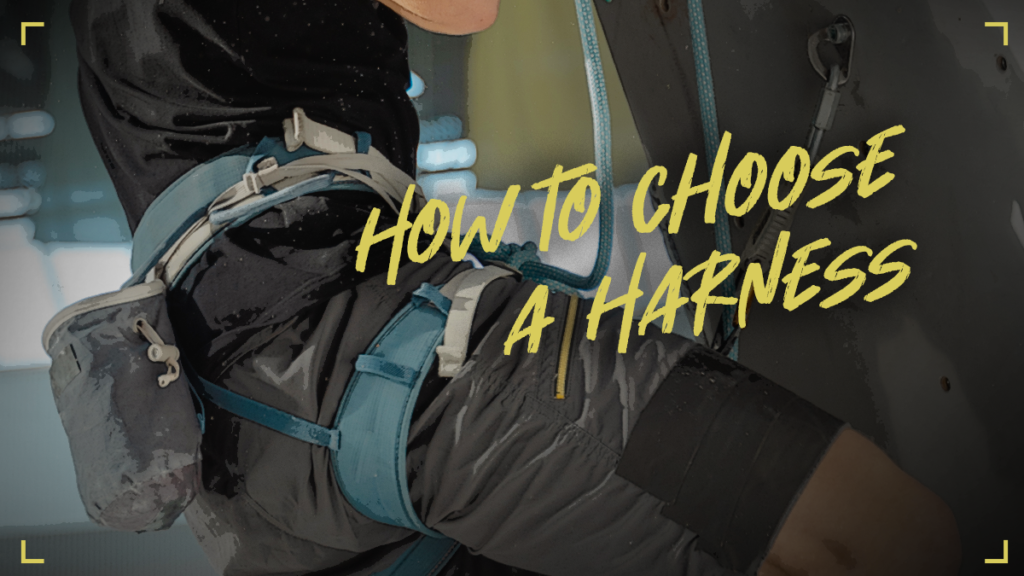Have you hit the gym a few times and now find yourself ready to take the next step in your climbing journey by purchasing your own harness? If so, read on! As a new climber, hunting for gear can feel overwhelming and intimidating. In this article, we will walk through a few types of harnesses, how to properly fit a harness, and give tips on making sure you’re investing in the gear that’s best for you.
Let’s start with the basics- different sorts of climbing harnesses. Harness types are abundant for all kinds of climbing, but this article will focus on the two harness types most commonly used for indoor climbing.
Sport or Gym Harnesses

Sport harnesses are the most basic style of climbing harnesses. Made to be minimal and lightweight, they lack some of the durability, comfort, and add-ons of other harnesses. The material and padding on sports harnesses tend to be thinner, offering less support and cushioning for your back, waist, and legs. Waistbands of sport harnesses will have either a single plate, automatic style buckle, or a two plate, double backing style buckle. Both types of buckles serve the same purpose. They’re just different equipment styles and therefore require other familiarities with the correct safety checks. The buckle’s ‘tail’ (the end of the material secured through and coming out from a buckle) is what you will use to adjust the tightness of your waistbelt and leg loops. Sport harnesses, however, often lack buckles for adjusting on leg loops, allowing a less personalized fit.
The final difference between the sport style and other harness types is the number of gear loops offered. Gear loops are found around the sides and backs of harnesses and offer places to, as the name suggests, attach gear to your harness. Gear loops are essential for folks engaging in types of climbing in which you need to take up more gear with you to be able to complete a route, such as lead climbing.
A sport harness may be just the thing for you if you are a more casual climber or looking for the cheapest end of the harness spectrum.
Trad Harnesses

Trad harnesses are the next step up from sport, offering more durability and features for more extended, gear-intensive climbing. Trad harnesses will be a bit heavier than a sport but are made with the comfort preferred for longer climbing sessions in mind. With this kind of harness, you will notice more support for your lower back and waist and will likely favor the padding offered to your waist and leg loops during longer routes. Unlike some sport harnesses, trad harnesses are equipped with buckles on leg loops for size adjustments. Auto lock vs. double backing buckles vary by individual harness, just as with sport harnesses. Trad harnesses will also offer a more significant number of gear loops and haul loops- a thicker loop found on the very back of your harness, used for attaching a second rope to your harness.
If you plan on climbing fairly regularly, continuing to expand your climbing skill pallet, or just looking for a little extra support on your body while you’re climbing, trad-style harnesses are an excellent investment. There are plenty of “hybrid” models as well that include attributes of both types of harnesses. Ask around the gym and see what other people like!
Next, let’s talk about what to consider when trying on a harness and how to check your harness for the proper size and fit.
Fit
Regarding sizing harnesses, one size will remain relatively true for you but always double-check your measurements, as different brand sizes can vary by a few marks. If possible, you should always try on a harness before making a decision, and, ideally, you should try on various harnesses to better compare styles and fit. When deciding on a harness fit, the main things to consider are correct sizing and comfort. A poorly padded harness can distinguish between a successful, enjoyable climb and a frustrating, uncomfortable one.
Let’s touch on the differences between men’s and women’s harnesses, as these differences are more specific to body type than gender. There are no significant differences between these categories of harnesses that would restrict a climber from wearing one or the other. They vary in measurements. Women’s harnesses tend to have smaller waist belts and larger leg loops, whereas men’s harnesses often have longer measurements between the waist loop and leg loops. It’s always a good idea to try on both versions of a harness you’re interested in, as you may find the fit or comfort of one is preferable to the other.
Size
When you put on your harness, you should always start by pulling the waist belt over your hip bones and tightening your waist before your leg loops. When worn and correctly adjusted, your harness should always rest above your hip bones or at the smallest point of your waist, depending on your body shape. When your harness is positioned and tightened correctly, you should be unable to pull it down past your hips.
To check your harness is tight enough, hold up two finger widths and place them flat against your stomach in between you and the harness. Turn your fingers perpendicular to your stomach, and they should not be able to remain side by side. Instead, they should have to twist as if you’re crossing your fingers for luck.
If your harness’s waistbelt has to overlap to tighten it correctly, it is too big. If you have an excess length of buckle tail that dangles from your harness more than a few inches when tucked in, your harness is too big.
If you find yourself with any less than 2-3 inches of buckle tail when correctly tightened, your harness is too small. Having these inches of the tail is critical as your harness will loosen slightly as you move and climb in your harness. These extra inches ensure the tail will not slip through the buckle and undo your harness.
Once you have checked your waistbelt fit and comfort, it’s time to move on to the leg loops! Here you focus a little more on comfort when it comes to tightness. Ideally, leg loops should be loose enough to slide your fingers between the loop and leg but tight enough to ensure no gap between your leg loop and leg.
Congratulations, you’re well on surpassing your rental harness days! Whatever harness you use, you can look forward to a more comfortable climb and look a little cooler when you hit the gym. Let us know your harness pick and why it was the one for you!

